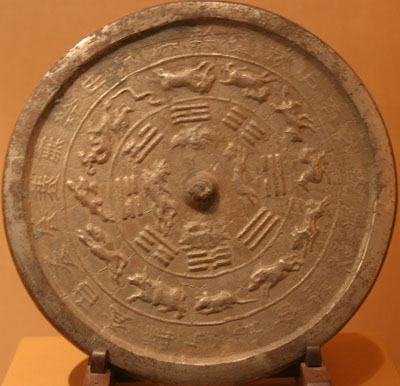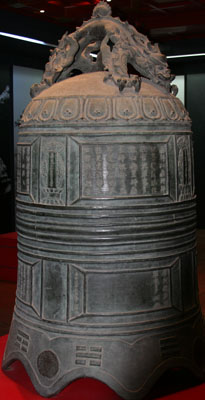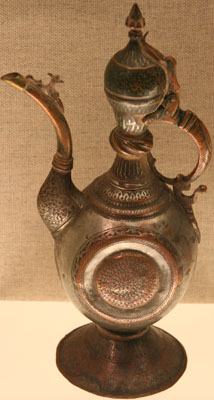Decorative Designs in Chinese Art 中国文物的纹饰
Bronze Ware 青铜器 Later Periods 后期
Click on any word to see more details.
Later Periods 后期
In later periods bronze lost its place as the centerpiece of imperial power. Bronze became more affordable to people outside sovereigns and high nobles. Also, other materials, such as iron and later steel, were developed that are lighter and stronger than bronze. However, bronze retained its place as a material of choice for certain artifacts, such as large bells and incense burners.

The twelve animals of the Terrestrial Branches 生肖, more loosely called the animals of the Chinese Zodiac, are the rat, ox, tiger, rabbit, dragon, snake, horse, sheep , monkey, rooster, dog, and boar. The rear of the bronze mirror above from the Five Dynasties shows twelve animals of the Terrestrial Branches around eight divinatory trigrams 八卦, combining multiple popular favorites in one art work. See Archetype, stars, trigrams and time vortex on a Chinese bronze mirror for a deeper discussion on designed for bronze mirrors.

Some of the bells in palaces, temples, and towers are huge. The Yongle bell, shown above, is 6.75 meters high and weighs 4.6 tonnes. The bell is decorated with Buddhist matras 咒 in both Chinese and Sanskrit. The top of the bell is decorated with a fierce looking dragon, indicating that is exclusively for imperial use. The circumference at the base is decorated with the traditional Chinese eight divinatory trigrams 八卦.

Statues of lions, usually placed in pairs on either side of an entrance, are a common site outside buildings in China. This is connected with their symbolism in Buddhism as being a defender of the Dharma. The copper lion statue above at the Lama Temple in Beijing is especially impressive. Besides the main sculpture the patterns on the base are intereting.

The two copper pitchers below from Xinjiang show an obvious Middle Eastern influence, including Arabic text. Uyger art has a distinctive mix of Chinese and Middle Eastern elements with the addition of something unique in itself. The pitcher immediately below has fine floral designs.

The pitcher below, from Kashgar, has an interesting spiral pattern, shown in detail on the right.
Chinese
Pinyin English
